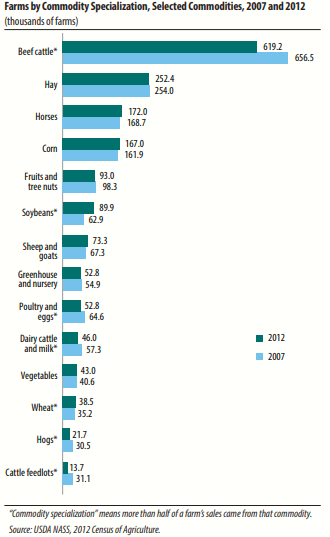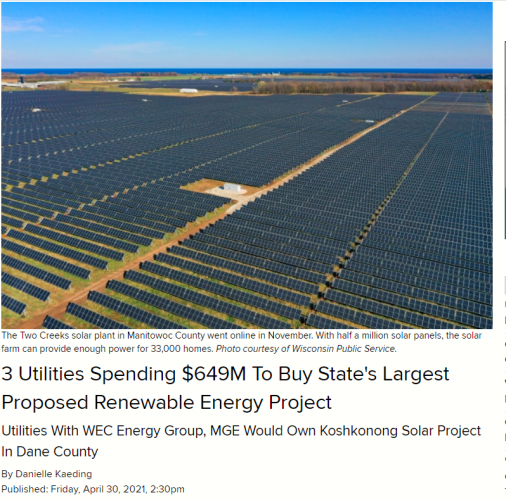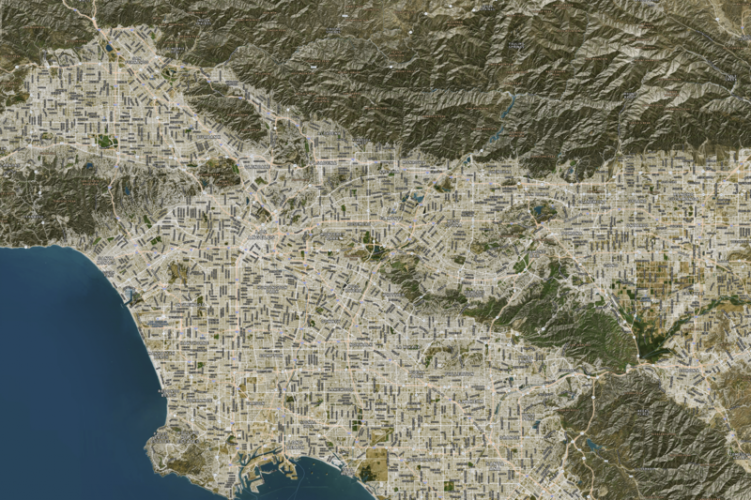Navigation
Install the app
How to install the app on iOS
Follow along with the video below to see how to install our site as a web app on your home screen.
Note: This feature may not be available in some browsers.
More options
You are using an out of date browser. It may not display this or other websites correctly.
You should upgrade or use an alternative browser.
You should upgrade or use an alternative browser.
Land requirements for renewable energy
- Thread starter Wildabeest
- Start date
thebestusernamesaretaken
Well-known member
- Joined
- Feb 19, 2021
- Messages
- 356
You know I was thinking about this because that's who I am and stuff like this keeps me up at night. It seems like the easiest solution is for the political elite is to take public lands for these and other uses. Now I know that some folks disagree with the existence of public land to begin with (think our good friends in the Great State of Texas), but I like em and would like to keep them around.
There is another (complicated), solution that may end up saving some capital expensive and repurpose some privately held land that could be affected. Now, this may end up changing some lives so it may be controversial.
It appears that we can grow many foods in repurposed warehouses closer to population centers which would cut down on transportation costs/exhaust emissions, increase food freshness, increase growing cycles and food production (i.e.. higher turn rates of the space being utilized to grow food), due to artificial photosynthesis. These systems seem to use less water, less soil (if any), and lower capital costs of farming equipment like tractors and large land purchases.
If this works it would likely cause a lot of farm land to be repurposed for energy uses or for growing elk herds. It would be terrible to see farm land lost to condos and further subdivisions as it contributes both to our food system and to our natural environment.

 www.ey.com
www.ey.com
There is another (complicated), solution that may end up saving some capital expensive and repurpose some privately held land that could be affected. Now, this may end up changing some lives so it may be controversial.
It appears that we can grow many foods in repurposed warehouses closer to population centers which would cut down on transportation costs/exhaust emissions, increase food freshness, increase growing cycles and food production (i.e.. higher turn rates of the space being utilized to grow food), due to artificial photosynthesis. These systems seem to use less water, less soil (if any), and lower capital costs of farming equipment like tractors and large land purchases.
If this works it would likely cause a lot of farm land to be repurposed for energy uses or for growing elk herds. It would be terrible to see farm land lost to condos and further subdivisions as it contributes both to our food system and to our natural environment.

Next up: Mark Oshima - farming up
Growing populations mean we need more food from less land, so vertical farming may be the key to building a better working world.
CoffeeGoat
Well-known member
- Joined
- Aug 23, 2020
- Messages
- 141
I just started a new gig in January working specifically on the intersection of energy, chemicals, and the grid and the industry is rife with this sort of "big talk," without any connection to reality. While the article does a nice job showing the "end" requirements of some of these goals, it fails to tack on the rather important "means," to achieve them. What do the lithium mines look like to build those battery arrays, what's the impact to the petrochemicals industry (including agriculture) once you make it illegal to vent CO2, what are we going to do with the e-waste that comes from those trillions and trillions of batteries and solar panels. I get the feeling the people who come up with these plans have never actually built something. They're so isolated from the real world that they truly believe that if they just tax and spend correctly the entire world can and will change overnight.
Don't get me wrong, I love what I'm doing, and I'm hopeful that it will make a difference, and think we can and should do better in enumerable ways, but we need to be a bit more circumspect with our rhetoric.
Don't get me wrong, I love what I'm doing, and I'm hopeful that it will make a difference, and think we can and should do better in enumerable ways, but we need to be a bit more circumspect with our rhetoric.
Take another hit. mtmuleyYou know I was thinking about this because that's who I am and stuff like this keeps me up at night. It seems like the easiest solution is for the political elite is to take public lands for these and other uses. Now I know that some folks disagree with the existence of public land to begin with (think our good friends in the Great State of Texas), but I like em and would like to keep them around.
There is another (complicated), solution that may end up saving some capital expensive and repurpose some privately held land that could be affected. Now, this may end up changing some lives so it may be controversial.
It appears that we can grow many foods in repurposed warehouses closer to population centers which would cut down on transportation costs/exhaust emissions, increase food freshness, increase growing cycles and food production (i.e.. higher turn rates of the space being utilized to grow food), due to artificial photosynthesis. These systems seem to use less water, less soil (if any), and lower capital costs of farming equipment like tractors and large land purchases.
If this works it would likely cause a lot of farm land to be repurposed for energy uses or for growing elk herds. It would be terrible to see farm land lost to condos and further subdivisions as it contributes both to our food system and to our natural environment.

Next up: Mark Oshima - farming up
Growing populations mean we need more food from less land, so vertical farming may be the key to building a better working world.www.ey.com
stevejfarms
Well-known member
You do realize you’re talking about replacing 300 million+ acres of farmland with greenhouses don’t you?You know I was thinking about this because that's who I am and stuff like this keeps me up at night. It seems like the easiest solution is for the political elite is to take public lands for these and other uses. Now I know that some folks disagree with the existence of public land to begin with (think our good friends in the Great State of Texas), but I like em and would like to keep them around.
There is another (complicated), solution that may end up saving some capital expensive and repurpose some privately held land that could be affected. Now, this may end up changing some lives so it may be controversial.
It appears that we can grow many foods in repurposed warehouses closer to population centers which would cut down on transportation costs/exhaust emissions, increase food freshness, increase growing cycles and food production (i.e.. higher turn rates of the space being utilized to grow food), due to artificial photosynthesis. These systems seem to use less water, less soil (if any), and lower capital costs of farming equipment like tractors and large land purchases.
If this works it would likely cause a lot of farm land to be repurposed for energy uses or for growing elk herds. It would be terrible to see farm land lost to condos and further subdivisions as it contributes both to our food system and to our natural environment.

Next up: Mark Oshima - farming up
Growing populations mean we need more food from less land, so vertical farming may be the key to building a better working world.www.ey.com
Gellar
Well-known member
Funny you mention this. This headline and picture caught my attention this morning. Actually the picture about made me puke. It looks like a wasteland to me.

 www.wpr.org
www.wpr.org

3 Utilities Spending $649M To Buy State's Largest Proposed Renewable Energy Project
Three Wisconsin utilities are planning to buy what is slated to become the single largest renewable energy plant in the state. Utilities owned by Milwaukee-based WEC Energy Group and Madison […]
thebestusernamesaretaken
Well-known member
- Joined
- Feb 19, 2021
- Messages
- 356
Yup - but it's really less space because food production turn rates and yield is higher under their method - like 27 times less. The company in the report is already feeding NYC. It's also less for food because much of that land isn't for food, its in ethanol production. I think that they only have plans for leafy greens and vining plants though. I haven't seen anything with root vegetables.You do realize you’re talking about replacing 300 million+ acres of farmland with greenhouses don’t you?
from the WWW
Cropland- About 349 million acres in the U.S. are planted for crops. This is the equivalent of about four states the size of Montana. Four crops -- feeder corn (80 million acres), soybeans (75 million acres), alfalfa hay (61 million acres) and wheat (62 million acres) -- make up 80 percent of total crop acreage.
The amount of land used to produce all vegetables in the U.S. is less than 3 million acres.

Last edited:
thebestusernamesaretaken
Well-known member
- Joined
- Feb 19, 2021
- Messages
- 356
My concern about these type of large scale projects is that people will be so enthralled about environmental progress away from fossil fuels that they will disregard any impact to wildlife. I don't know that it's bad, but I don't know if its good either. Look at that footprint, it's huge and I imagine a huge fence around it as well. I hope that someone took wildlife in consideration to provide mitigation efforts to it's potential negative impact.Funny you mention this. This headline and picture caught my attention this morning. Actually the picture about made me puke. It looks like a wasteland to me.

3 Utilities Spending $649M To Buy State's Largest Proposed Renewable Energy Project
Three Wisconsin utilities are planning to buy what is slated to become the single largest renewable energy plant in the state. Utilities owned by Milwaukee-based WEC Energy Group and Madison […]www.wpr.org

DouglasR
Well-known member
Yeah, how do I find out where they’re going to be building these things in the future?
I’d really like to sell my rural Illinois home a couple years before they convert the ag fields surrounding said home into solar fields because that’s not doing anything for my property value.
gross.
I’d really like to sell my rural Illinois home a couple years before they convert the ag fields surrounding said home into solar fields because that’s not doing anything for my property value.
gross.
If only there were hundreds of millions of developed acres on which we could afix solar and wind power generators so as to not chew up more land, public or private.
View attachment 182299
so much harder to swindle the private property owner than the public land owner for cheap leasing and ROI though, right?
thebestusernamesaretaken
Well-known member
- Joined
- Feb 19, 2021
- Messages
- 356
I like it - issue is all those pesky land and building owners who are going to want their cut. Large scale private projects from energy companies would typically want to have control of their equipment on other folks personal property.If only there were hundreds of millions of developed acres on which we could afix solar and wind power generators so as to not chew up more land, public or private.
View attachment 182299
A solution could be a government incentive to put solar panels on their personal rooftops and feed back energy into the grid. I imagine that there will be a use fee for using the grid owned by utilities but that could work.
BigHornRam
Well-known member
Just depends how much you are willing to spend for your electricity.If only there were hundreds of millions of developed acres on which we could afix solar and wind power generators so as to not chew up more land, public or private.
View attachment 182299

Tesla Solar Roof price increase explained: why it’s suddenly soared in cost
Tesla's solar-harvesting tiles have seen a price increase. Here's why.
noharleyyet
Well-known member
The huge solar field just south off 287 on the east side of Amarillo mirages a lake....so we've got that going for us.
*Atlas keeps shrugging...
*Atlas keeps shrugging...
Just depends how much you are willing to spend for your electricity.

Tesla Solar Roof price increase explained: why it’s suddenly soared in cost
Tesla's solar-harvesting tiles have seen a price increase. Here's why.www.inverse.com
I defer to @jryoung on the economics of it all, but you're comparing single point application to a discussion about mass power generation.
We're looking at solar to get moving this summer. If I can disconnect from the grid, great. If I can generate energy & get paid for it, even better. It's worth the investment.
BigHornRam
Well-known member
Like this government incentive program?I like it - issue is all those pesky land and building owners who are going to want their cut. Large scale private projects from energy companies would typically want to have control of their equipment on other folks personal property.
A solution could be a government incentive to put solar panels on their personal rooftops and feed back energy into the grid. I imagine that there will be a use fee for using the grid owned by utilities but that could work.
Federal Solar Tax Credit in 2024: Complete Guide
Learn all about the federal investment tax credit (ITC), also known as the federal solar tax credit, which saves you money on solar.
BigHornRam
Well-known member
Good luck Ben. Do your due diligence and let me know how it goes. Let wllm do the spread sheets if it gets complicated.I defer to @jryoung on the economics of it all, but you're comparing single point application to a discussion about mass power generation.
We're looking at solar to get moving this summer. If I can disconnect from the grid, great. If I can generate energy & get paid for it, even better. It's worth the investment.
thebestusernamesaretaken
Well-known member
- Joined
- Feb 19, 2021
- Messages
- 356
Yes, but I think that it's going to have to be better than that to get all those folks to change. It's going to need to be a public works project like building the highway system or railroad big to do what they want to do.Like this government incentive program?
Federal Solar Tax Credit in 2024: Complete Guide
Learn all about the federal investment tax credit (ITC), also known as the federal solar tax credit, which saves you money on solar.www.energysage.com
Good luck Ben. Do your due diligence and let me know how it goes. Let wllm do the spread sheets if it gets complicated.
It's a bit daunting to suss it all out, but early indications look good. We'd be spending the same for a system that we'll own in 10 years as we would throwing it away on a utility each month.
Spreadsheets are for folks who can't math in their heads.
2+2 = Epstein didn't hang himself.
See, I are smart.
Similar threads
- Replies
- 64
- Views
- 4K
- Replies
- 7
- Views
- 1K





